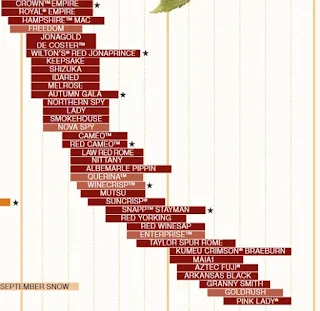Big D, one of Kubota's friends was visiting yesterday.
I commented, "That was a great looking rack you had sitting in your truck the other day."
Big D furrowed his brows in concentration. "What day was that?"
"I don't know. Monday?" I ventured trying to remember the last time I saw him drive his truck down the road. "Why would that matter?"
"Because I am currently dating three different women." Big D said. "I wasn't sure which one you were talking about."
I think he was joking with me.
I was able to clarify that I meant the deer antlers that were piling up on the dash of his truck. Big D likes looking for sheds.
 |
| A slightly different angle |
In the middle-ages people thought that some types of mushrooms signified where a coven of witches recently had an orgy with demons. I have no idea where they would come up with an idea like that.
More tree planting. I think I am done with the apple and pear trees at Salamander's farm for this year. I got sixty in the "serious" orchard and forty planted out in the pucker-brush to attract deer.
 |
| You can click to embiggen. The area circled in red is where the apple and pear trees went in. As you can see from this image and the one shown above, there is still much canopy blocking light. |
 |
| If I remember correctly, the distance from the horizontal line near the middle of the image to the bottom of the image is a 120 yard shot. |
 |
| One American Elm shaded one of my plantings of nine pears. I did not want to bother with dropping the tree so I ringed it. |
Pyrus calleryana rootstocks. Oregon State University says this about "P. cally"
Trees on seedlings of P. calleryana have shown about as much decline as trees on Winter Nelis seedling and somewhat less decline than trees on Bartlett seedling. P. calleryana is not sufficiently winter hardy for use in areas where winter injury has been a problem. Trees on P. calleryana are vigorous, but in contrast to most vigorous stocks, they begin bearing at an early age. The mature trees are slightly smaller than those on P. com-munis seedling. P. calleryana is resistant to oak root fungus, Phytophthora root rot, and crown gall. It also tolerates wet soil better than other stocks. It is subject, to lime-induced chlorosis. Seedling P. calleryana is often the best choice of seedling rootstock for any pear variety but particularly for Cornice, Bosc, and Seckel. -Source
 |
| Fruit ripening data from Adams County Nursery. Data is from southeastern Pennsylvania but is fairly accurate for my part of Michigan. Leftmost vertical line is September first. Rightmost vertical line is November first. Michigan bow season starts October first. Michigan regular firearm season starts November 15. |




No comments:
Post a Comment
Readers who are willing to comment make this a better blog. Civil dialog is a valuable thing.